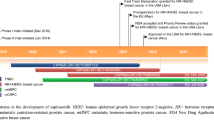Abstract
Patients with a pathologically proven diagnosis of malignant melanoma were entered into a phase II trial of bisantrene. Eligibility criteria included: measurable, metastatic disease; performance status 0–2 SWOG; and adriamycin total cumulative dose of < 400 mg/m2. The initial bisantrene dosing schedule was 260 mg/m2 every three weeks for good risk patients. Due to the absence of an objective response and the lack of severe toxicity in the first 25 bisantrene treated patients, the starting dose was increased to 300 mg/m2 for good risk patients. Fifty-one patients received a median of two bisantrene courses (range 1–11 courses). Leukopenia was the major toxicity. Fifteen (68%) of the 22 good risk, intermediate dose patients (260 mg/m2), and 8 (80%) of the 10 good risk, high dose patients (300 mg/m2) evaluable for toxicity experienced mild-severe leukopenia. None of the 51 patients experienced a complete or partial response to bisantrene. Median survival was 3.3 months. We conclude that bisantrene is ineffective in the treatment of metastatic melanoma.
Similar content being viewed by others
References
Yap H, Yap B, Blumenschein GR, Barnes BC, Schell FC, Bodey GP: Bisantrene, an active new drug in the treatment of metastatic breast cancer. Cancer Res 43:1402–1404, 1983
Osborn CK, Von Hoff DD, Cowan JD, Sandbach J: Bisantrene, an active drug in patients with advanced breast cancer. Cancer Treat Rep 68:357–360, 1984
Von Hoff DD, Forseth B, Metelmann H, Harris G, Rowan S, Coltman CA: Direct cloning of human malignant melanoma in soft agar culture. Cancer 50:696–701, 1982
Alberts DS, Mackel C, Pocelinko R, Salmon SE: Phase I clinical investigation of 9,10-anthracenedicarboxaldehyde bis [(4,5-dihydro-1H-imidazol-2-yl) hydrazone] dihydrochloride with correlative in vitro human tumor clonogenic assay. Cancer Res 42:1170–1175, 1982
Von Hoff DD, Coltman Jr CA, Forseth B, Pocelinko R: Activity of CL 216,942 9,10-anthracenedicarboxaldehyde bis [(4,5-dihydro-1H-imidazol-2-yl) hydrazone] dihydrochloride (CL 216,942) in a human tumor cloning system: Leads for phase II trials in man. Cancer Chemother Pharmacol 6:141–144, 1981
Salmon SE, Meyskens Jr FL, Alberts DS, Soehnlen B, Young L. New drugs in ovarian cancer and malignant melanoma: in vitro phase II screening with the human tumor clonogenic cell assay. Cancer Treat Rep 65:1–12, 1981
Speigel RJ, Levin M, Cumps E, Muggia F: Phase II trial of bisantrene in melanoma with clonogenic assay correlations. Proc Am Soc Clin Onc 1:175, 1982
Mackel C, Meyskens Jr FL, Alberts DS: Phase II trial of bisantrene in patients with metastatic melanoma. Cancer Treat Rep, submitted, 1985
Author information
Authors and Affiliations
Additional information
Address for offprints: Southwest Oncology Group (SWOG-8118), Operations Office, 5430 Fredericksburg Road, Suite #618, San Antonio, TX 78229, USA
Rights and permissions
About this article
Cite this article
Alberts, D.S., Mason-Liddil, N., Green, S.J. et al. Phase II evaluation of bisantrene hydrochloride in refractory malignant melanoma. Invest New Drugs 5, 289–292 (1987). https://doi.org/10.1007/BF00175300
Issue Date:
DOI: https://doi.org/10.1007/BF00175300




